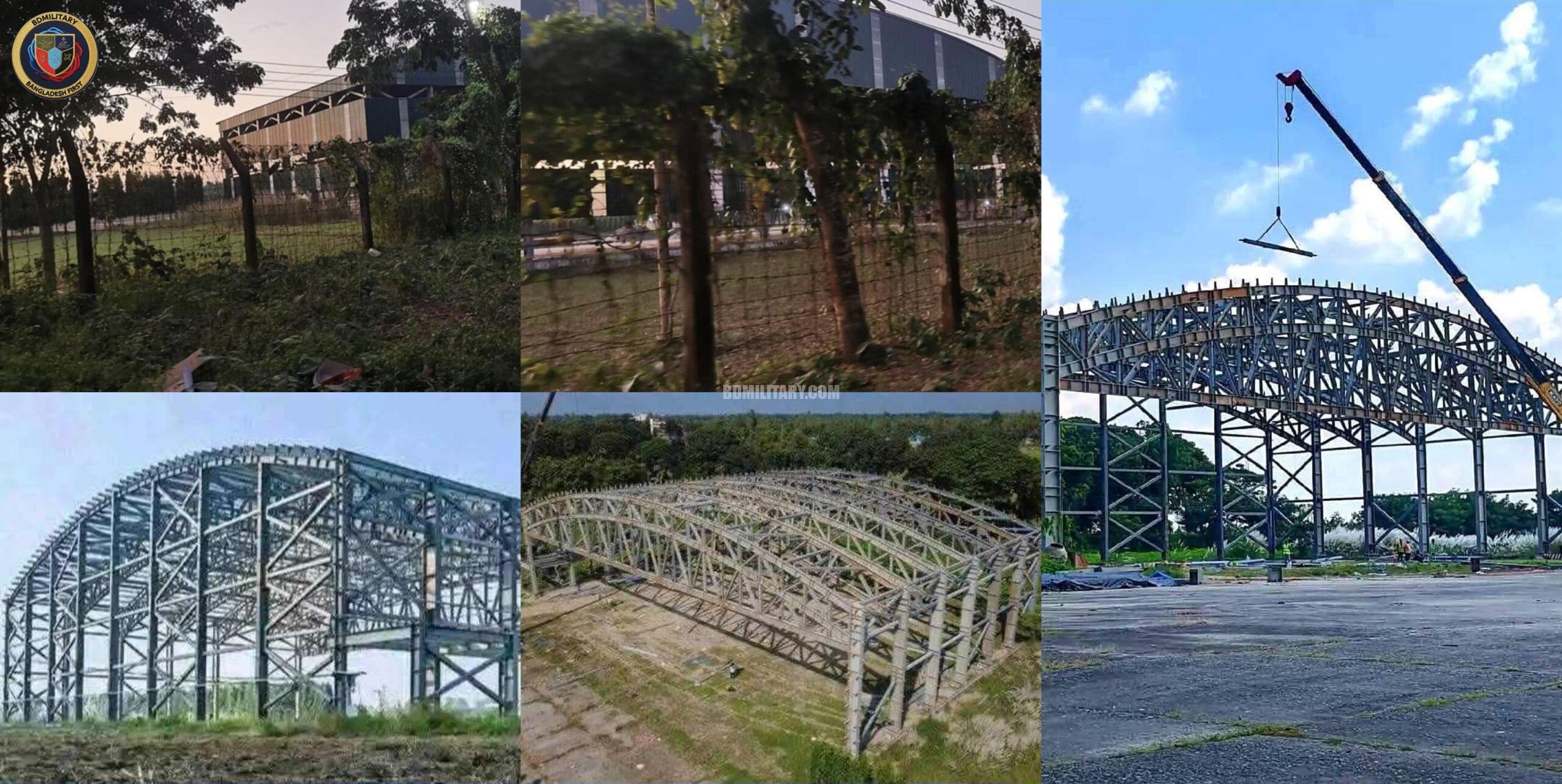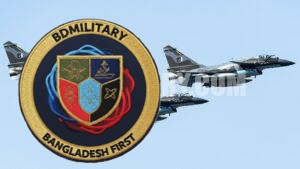Strategic Consolidation in the North
Bangladesh’s defence establishment has quietly resumed full operational activity from its northern airbases at Lalmonirhat and Thakurgaon, in line with long-term national security planning and air mobility requirements under Forces Goal 2030. Both airfields—once used intermittently for training and logistical operations—are being revitalised to support Army Aviation, UAV operations, and integrated air defence units.
Sources within the defence community confirm that the Bangladesh Army Aviation Group has undertaken extensive infrastructure work at Lalmonirhat, including the construction of a modern MRO (Maintenance, Repair and Overhaul) facility, new aircraft hangars, and air defence emplacement sites designed to secure northern airspace. The objective is to strengthen national air operations capability, reduce logistical response time in the Rangpur division, and provide enhanced surveillance and support to ground formations deployed near key northern sectors.
Indian Media in Overdrive
The resumption of these projects has triggered a wave of alarmist reporting in sections of the Indian media. A recent article published by Northeast News, authored by Chandan Nandy, claimed that Bangladesh was “violating” an earlier assurance allegedly made by Brigadier General Nazim-ud-Daula on 26 May 2025, that Lalmonirhat would not be used for military purposes. The report went on to allege that the base is being converted into a “missile and drone facility” located close to India’s “Chicken’s Neck”, the narrow Siliguri Corridor linking the Indian mainland with its northeastern states.
However, defence sources in Dhaka have dismissed the allegations as misleading and speculative, pointing out that no Indian military intelligence delegation has visited Lalmonirhat, contrary to the claims repeated by Indian outlets. The airbase, they note, remains under exclusive control of the Bangladesh Armed Forces, and work is proceeding strictly according to Bangladesh’s internal defence infrastructure development plan.
Reality on the Ground
The upgrade at Lalmonirhat is focused primarily on enhancing Army Aviation operational readiness and ensuring that fixed and rotary-wing aircraft such as C295W transport aircraft and Mi-171E combat-support helicopters and potential future platforms can be maintained and deployed with greater efficiency. The MRO capability being developed will enable the servicing of helicopter fleets, extending flight endurance during emergency and disaster response missions, as well as rapid troop mobility in the northern region.
Additionally, the airbase is being prepared for UAV and reconnaissance drone operations, complementing the Army’s expanding aerial surveillance capability. Bangladesh already operates the Bayraktar TB2 UAV, with plans for further tactical and MALE drone acquisitions from Türkiye and China. Establishing a northern UAV hub allows real-time monitoring of border areas and ensures a full situational awareness picture across northern Bangladesh—particularly vital given the sensitive cross-border environment.
The Strategic Geography
Lalmonirhat’s geographic position near Bangladesh’s northern border has long been of interest to both military planners and observers. The airfield lies roughly 16 kilometres from the Siliguri Corridor, the narrow Indian passage between Nepal and Bangladesh that connects mainland India to its northeastern states.
While Indian analysts frequently cite this proximity as a “strategic concern”, Dhaka’s defence planners view the base through a purely sovereign and logistical lens. Northern Bangladesh remains a crucial zone for internal transport, disaster response, and supply chain management between Rangpur and adjacent divisions. Upgrading air facilities there ensures that Bangladesh maintains autonomous operational reach across its entire territory without reliance on southern or central bases during emergencies or contingencies.
Indian Security Establishment Reacts
The response from Indian security analysts has been one of unease and, in some cases, open panic. Indian parliamentarians have raised the issue in the Lok Sabha, with the Minister of State for External Affairs acknowledging on 8 August that India has “noted” reports concerning Lalmonirhat airbase. Yet, the minister’s own statement stopped short of confirming any verified intelligence on military deployment or weaponisation, underlining the lack of concrete evidence behind the speculation.
Despite this, Indian media outlets continue to circulate photographs of hangar construction and radar components, often without context. Defence observers in Dhaka highlight that modern hangars and radar installations are standard for any operational air facility—especially one supporting UAV and aviation assets. The attempt to portray such development as a military escalation reflects India’s growing discomfort with Bangladesh’s independent modernisation trajectory.
No Violation of Assurances
The suggestion that Bangladesh has violated an earlier “assurance” is also inaccurate. The May 26 press briefing by the Bangladesh Army’s Director of Military Operations merely stated that there were no current plans at that time for using Lalmonirhat for combat purposes. This does not constitute a permanent or binding commitment, nor does it restrict the sovereign right of Bangladesh to resume operations as strategic needs evolve.
Moreover, there is no record of any bilateral or treaty-level agreement limiting Bangladesh’s use of its own territory for defence infrastructure. The current work therefore remains fully compliant with both domestic and international law.
Strategic Autonomy and Sovereignty
The broader picture reveals that Bangladesh’s northern airbase revival is part of a wider pattern of force redistribution and infrastructure strengthening under Forces Goal 2030. The plan emphasises decentralisation of command, mobility, and resilience. By activating secondary bases such as Lalmonirhat and Thakurgaon, the armed forces aim to ensure continuous operations even under crisis conditions, including natural disasters, external threats, or disruptions to primary installations.
In addition to aviation facilities, air defence elements are being prepared to safeguard these bases against aerial threats. This involves radar coverage integration and point-defence systems—again, a standard measure for any operational airbase.
Indian Narrative vs. Ground Reality
The current wave of Indian media reports mirrors a familiar pattern of disinformation and sensationalism whenever Bangladesh undertakes defence-related activity close to the border. Similar narratives were observed during Bangladesh’s acquisition of Turkish UAVs, Chinese radar systems, and naval ship upgrades. In each case, Indian outlets attempted to frame normal defence modernisation as a “provocation”.
Bangladesh’s policy, however, remains consistent: to modernise its forces to protect national sovereignty, enhance regional stability, and ensure readiness against any form of external or asymmetric threat. The country’s security institutions continue to operate transparently within their jurisdiction, without violating any regional norms.
Outlook
The Lalmonirhat and Thakurgaon projects are expected to be operationally complete within the next two years, providing the Army Aviation Group with additional basing depth and maintenance capacity. This will greatly enhance the mobility of both aviation and ground forces in northern Bangladesh, improve response times during national emergencies, and expand surveillance coverage.
While alarmist claims continue across the border, the reality is clear: Bangladesh’s northern airbases are being modernised not for aggression, but for preparedness. The panic in New Delhi reflects not any threat from Dhaka, but rather India’s discomfort with Bangladesh’s growing strategic self-reliance.

Khaled Ahmed is a seasoned former intelligence analyst and military expert from the Netherlands, bringing over 15 years of specialised experience in operational intelligence, threat analysis, and strategic defence planning. Having served in high-level, classified roles within Dutch military intelligence, he possesses rare expertise in European security architecture, NATO doctrine, and asymmetric warfare. Khaled’s deep operational insight and international perspective enable him to deliver precision-driven intelligence analysis and forward-looking strategic forecasts. A trusted contributor to high-level risk assessments and security briefings, he offers readers clarity on complex defence and security challenges. Khaled leads the National Security and Fact Analysis sections at BDMilitary. He holds a Master’s degree in International Relations from the University of Groningen, The Netherlands, and is fluent in Dutch, French, and Arabic — combining linguistic dexterity with operational expertise to analyse security issues across cultures and regions.


